
Concept explainers
(a)
Interpretation:
The structure from the given IUPAC name with appropriate stereochemistry is to be drawn.
Concept introduction:
The root name in the given IUPAC name suggests the main chain or ring of carbon atoms in the compound. The suffix to root name indicates the highest priority
The stereochemical designation and the locators are enclosed in parenthesis at the very beginning of the name. The stereochemistry at the chiral center is determined by assigning the priorities to the groups attached to the chiral center on the basis of
Answer to Problem E.48P
The structure for IUPAC name
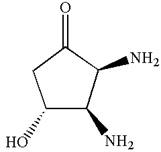
Explanation of Solution
The given IUPAC name is
The root name in this IUPAC name ‘cyclopentan’ represents the main ring of five carbon atoms. The suffix ‘one’ represents the highest priority functional group -

The structure has three chiral centers,
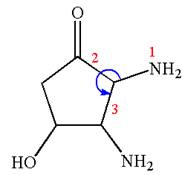
Thus, for absolute configuration
The absolute configuration at
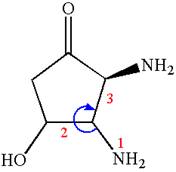
Thus, for absolute configuration
The absolute configuration at
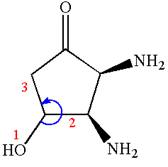
Thus for absolute configuration
Hence, the structure for is
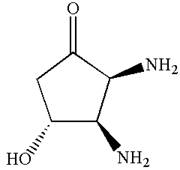
The structure for the given IUPAC name is drawn by identifying the highest priority functional group from the suffix, main chain from root name, and the position for the substituents from the locant with appropriate stereochemistry.
(b)
Interpretation:
The structure from the given IUPAC name with appropriate stereochemistry is to be drawn.
Concept introduction:
The root name in the given IUPAC name suggests the main chain or ring of carbon atoms in the compound. The suffix to root name indicates the highest priority functional group. The prefix with locant number indicates the number of substituents and their respective position at the main chain or at a ring of carbon atoms.
The stereochemical designation and the locators are enclosed in parenthesis at the very beginning of the name. The stereochemistry at the chiral center is determined by assigning the priorities to the groups attached to chiral center on the basis of atomic number of directly bonded atom. If the sequence of priority order
Answer to Problem E.48P
The structure for IUPAC name
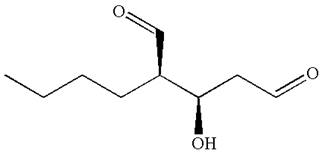
Explanation of Solution
The given IUPAC name is
The root name in this IUPAC name ‘pentane’ represents the main chain of five carbon atoms. The suffix ‘dial’ represents the highest priority functional group
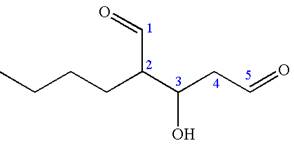
The structure has two chiral centers,
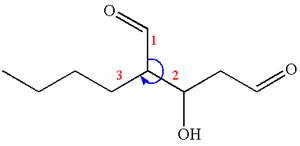
Thus, for the absolute configuration
The absolute configuration at
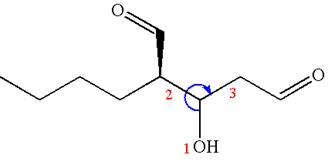
Thus for the absolute configuration
Hence, the structure for
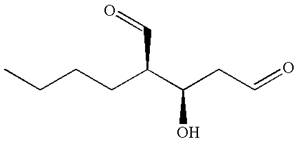
The structure for the given IUPAC name is drawn by identifying the highest priority functional group from the suffix, main chain from root name, and the position for the substituents from the locant with appropriate stereochemistry.
(c)
Interpretation:
The structure from the given IUPAC name with appropriate stereochemistry is to be drawn.
Concept introduction:
The root name in the given IUPAC name suggests the main chain or ring of carbon atoms in the compound. The suffix to root name indicates the highest priority functional group. The prefix with locant number indicates the number of substituents and their respective position at the main chain or at a ring of carbon atoms.
The stereochemical designation and the locators are enclosed in parenthesis at the very beginning of the name. The stereochemistry at the chiral center is determined by assigning the priorities to the groups attached to chiral center on the basis of atomic number of directly bonded atom. If the sequence of priority order
Answer to Problem E.48P
The structure for IUPAC name
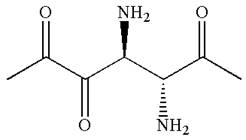
Explanation of Solution
The given IUPAC name is
The root name in this IUPAC name ‘heptane’ represents the main chain of seven carbon atoms. The suffix ‘
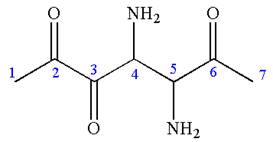
The structure has two chiral centers,
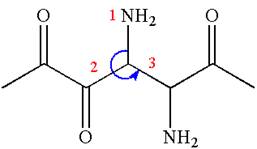
Thus, for the absolute configuration
The absolute configuration at

Thus, for the absolute configuration
Hence, the structure for

The structure for the given IUPAC name is drawn by identifying the highest priority functional group from the suffix, main chain from root name and the position for the substituents from the locant with appropriate stereochemistry.
(d)
Interpretation:
The structure from the given IUPAC name with appropriate stereochemistry is to be drawn.
Concept introduction:
The root name in the given IUPAC name suggests the main chain or ring of carbon atoms in the compound. The suffix to root name indicates the highest priority functional group. The prefix with locant number indicates the number of substituents and their respective position at the main chain or at a ring of carbon atoms.
The stereochemical designation and the locators are enclosed in parenthesis at the very beginning of the name. The stereochemistry at the chiral center is determined by assigning the priorities to the groups attached to chiral center on the basis of atomic number of directly bonded atom. If the sequence of priority order
Answer to Problem E.48P
The structure for IUPAC name
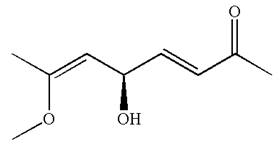
Explanation of Solution
The given IUPAC name is
The root name in this IUPAC name ‘octa’ represents the main chain of eight carbon atoms. The suffix ‘

The structure has one chiral center,
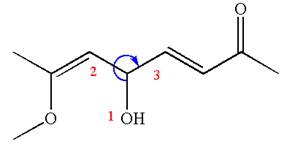
Thus for the absolute configuration
Hence, the structure for

The structure for the given IUPAC name is drawn by identifying the highest priority functional group from the suffix, main chain from root name and the position for the substituents from the locant with appropriate stereochemistry.
Want to see more full solutions like this?
Chapter E Solutions
Organic Chemistry: Principles And Mechanisms: Study Guide/solutions Manual (second)
- I need help with the followingarrow_forwardFor Raman spectroscopy/imaging, which statement is not true regarding its disadvantages? a) Limited spatial resolution. b) Short integration time. c) A one-dimensional technique. d) Weak signal, only 1 in 108 incident photons is Raman scattered. e) Fluorescence interference.arrow_forwardUsing a cell of known pathlength b = 1.25115 x 10-3 cm, a water absorption spectrum was measured. The band at 1645 cm-1, assigned to the O-H bending, showed an absorbance, A, of 1.40. a) Assuming that water density is 1.00 g/mL, calculate the water molar concentration c (hint: M= mole/L) b) Calculate the molar absorptivity, a, of the 1645 cm-1 band c) The transmitted light, I, can be written as I= Ioexp(-xb), where x is the absorption coefficient (sometimes designated as alpha), Io is the input light, and b is the cell pathlength. Prove that x= (ln10)*x*c. (Please provide a full derivation of the equation for x from the equation for I). d) Calculate x for the 1645 cm-1 bandarrow_forward
- For CARS, which statement is not true regarding its advantages? a) Contrast signal based on vibrational characteristics, no need for fluorescent tagging. b) Stronger signals than spontaneous Raman. c) Suffers from fluorescence interference, because CARS signal is at high frequency. d) Faster, more efficient imaging for real-time analysis. e) Higher resolution than spontaneous Raman microscopy.arrow_forwardDraw the major product of the Claisen condensation reaction between two molecules of this ester. Ignore inorganic byproducts. Incorrect, 5 attempts remaining 1. NaOCH3/CH3OH 2. Acidic workup Select to Draw O Incorrect, 5 attempts remaining The total number of carbons in the parent chain is incorrect. Review the reaction conditions including starting materials and/or intermediate structures and recount the number of carbon atoms in the parent chain of your structure. OKarrow_forwardUsing a cell of known pathlength b = 1.25115 x 10-3 cm, a water absorption spectrum was measured. The band at 1645 cm-1, assigned to the O-H bending, showed an absorbance, A, of 1.40. a) Assuming that water density is 1.00 g/mL, calculate the water molar concentration c (hint: M= mole/L) b) Calculate the molar absorptivity, a, of the 1645 cm-1 band c) The transmitted light, I, can be written as I= Ioexp(-xb), where x is the absorption coefficient (sometimes designated as alpha), Io is the input light, and b is the cell pathlength. Prove that x= (ln10)*x*c d) Calculate x for the 1645 cm-1 bandarrow_forward
 Organic ChemistryChemistryISBN:9781305580350Author:William H. Brown, Brent L. Iverson, Eric Anslyn, Christopher S. FootePublisher:Cengage Learning
Organic ChemistryChemistryISBN:9781305580350Author:William H. Brown, Brent L. Iverson, Eric Anslyn, Christopher S. FootePublisher:Cengage Learning
